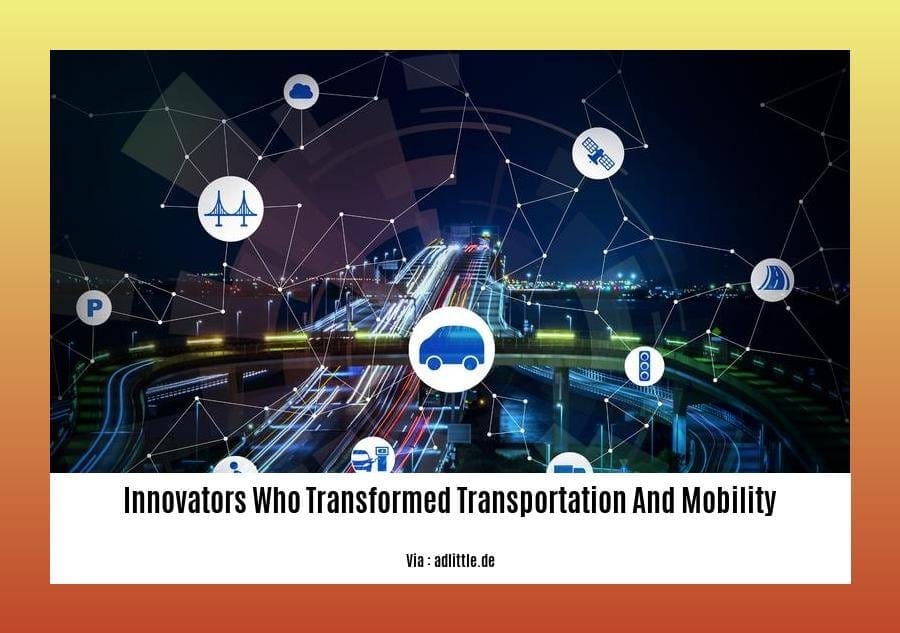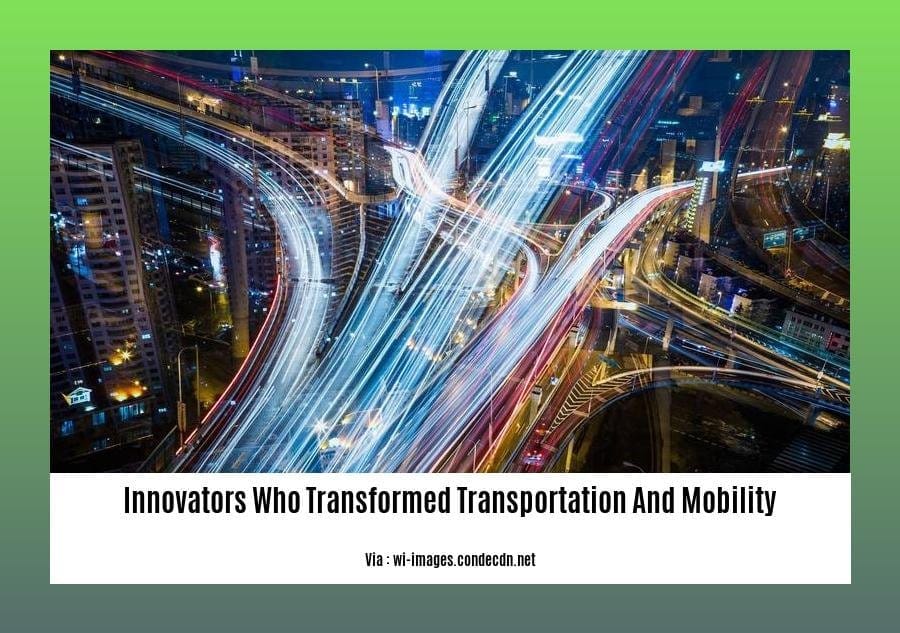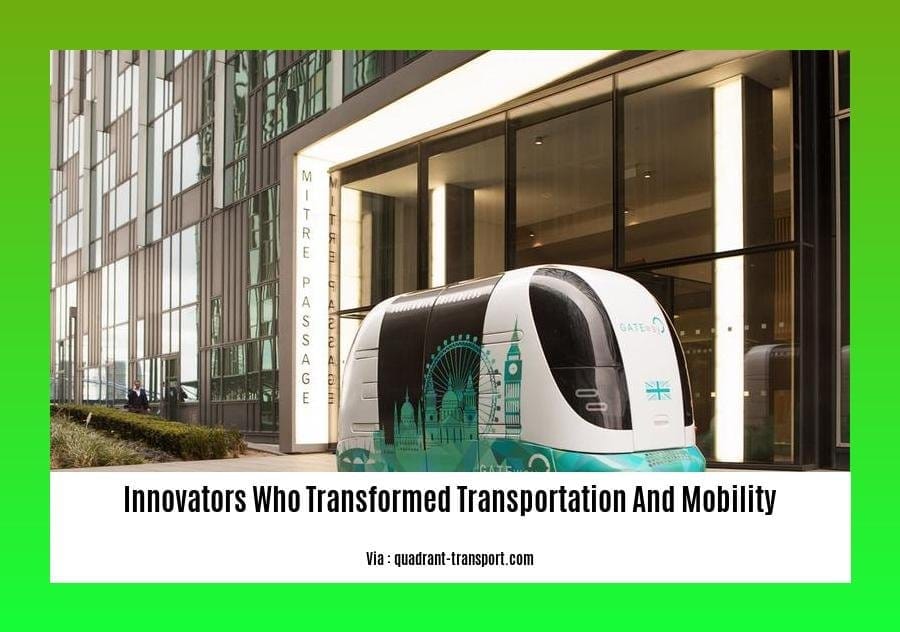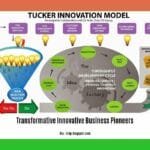Prepare to embark on an enthralling journey through the annals of transportation history with “Innovators Who Transformed Transportation and Mobility: Paving the Way for the Future.” This captivating article delves into the transformative contributions of visionary minds who revolutionized the way we travel and shaped the fabric of our modern world. Join us as we uncover the groundbreaking innovations that propelled humanity westward, unlocking new frontiers and forever altering the course of human mobility.
Key Takeaways:

- Smart city innovations enhance transportation efficiency.
- BestParking by ParkWhiz improves parking management for increased efficiency.
- Libelium’s Smart Parking Node utilizes radar technology to detect open parking spaces.
- Starfinder provides real-time tracking for public transportation optimization.
- Urbiotica’s U-Flow Traffic Sensor monitors traffic flow for congestion management.
Innovators Who Transformed Transportation and Mobility
Innovators who transformed transportation and mobility have reshaped the way we move around our world. From the invention of the automobile to the development of ride-sharing apps, these pioneers have consistently challenged the status quo and pushed the boundaries of what’s possible in the realm of mobility.
Smart City Innovations
In today’s increasingly urbanized world, smart city innovations are playing a pivotal role in enhancing transportation efficiency. Companies like BestParking by ParkWhiz and Libelium are revolutionizing parking management, while Starfinder and Urbiotica are optimizing public transportation and traffic flow.
BestParking by ParkWhiz provides real-time parking availability information, making it easier for drivers to find open spaces and reduce congestion caused by endless circling.
Libelium’s Smart Parking Node utilizes radar technology to detect occupied and vacant parking spaces, enabling cities to manage their parking resources more effectively.
Starfinder provides real-time tracking and predictive analytics for public transportation systems, allowing operators to optimize routes and reduce passenger wait times.
Urbiotica’s U-Flow Traffic Sensor monitors traffic flow and provides real-time data to help cities manage congestion, reduce emissions, and improve road safety.
These technologies are not only making our cities more livable and efficient but also paving the way for the future of transportation, where seamless connectivity and sustainable mobility will be the norm.
Discover the intrepid pioneers who revolutionized travel and transit, whose innovations transformed the way we move. From the transportation pioneers behind mobility breakthroughs to the landmark innovations in movement and transport, their legacies continue to shape our world today.
How did innovation in transportation push Americans westward?
In the 19th century, the United States experienced a period of rapid westward expansion. This expansion was driven in part by a number of innovations in transportation that made it easier for people to travel west.
Key Innovations
The most significant transportation innovation of the 19th century was the Erie Canal. The Erie Canal connected the Great Lakes to the Hudson River, and it made it possible for settlers to travel west more quickly and cheaply than ever before.
Another important innovation was the stagecoach. Stagecoaches were horse-drawn vehicles that could carry passengers and freight long distances. Stagecoach lines were established throughout the West, and they made it possible for people to travel to even the most remote areas.
The most iconic transportation innovation of the 19th century was the Transcontinental Railroad. The Transcontinental Railroad was completed in 1869, and it connected the East and West Coasts of the United States. The Transcontinental Railroad made it possible for people to travel west in just a few days, and it had a profound impact on the development of the United States.
Effects of Transportation Innovations
The innovations in transportation that occurred in the 19th century had a profound impact on the United States. These innovations made it possible for people to travel west more quickly and cheaply than ever before, and they helped to fuel the westward expansion of the United States. The westward expansion of the United States had a number of positive and negative consequences, but it is clear that the innovations in transportation that occurred in the 19th century played a major role in shaping the history of the United States.
Key Takeaways:
- The Erie Canal connected the Great Lakes to the Hudson River, making it easier and cheaper for settlers to travel west.
- Stagecoaches were horse-drawn vehicles that could carry passengers and freight over long distances, opening up the West to even more people.
- The Transcontinental Railroad was completed in 1869, connecting the East and West Coasts and making it possible to travel west in just a few days.
- These transportation innovations dramatically increased the speed and ease of westward travel, leading to the rapid expansion of the United States in the 19th century.
Citation:
Ashton, Patti. “Innovation in Transportation.” State Historical Society of Iowa. State Historical Society of Iowa, n.d. Web. 10 Feb. 2023.

FAQ
Q1: How did innovations in transportation contribute to westward expansion?
A1: Innovations in transportation, such as the Erie Canal, stagecoaches, and the Transcontinental Railroad, facilitated the movement of settlers and migrants, the marketing of crops and livestock, and communication with the East, accelerating westward expansion.
Q2: What was the significance of the Erie Canal?
A2: The Erie Canal, completed in 1825, was a major innovation that connected the Great Lakes to the Atlantic Ocean, providing a vital waterway for trade and transportation, facilitating the settlement and economic development of the Northwest Territory.
Q3: How did stagecoaches impact westward expansion?
A3: Stagecoaches played a crucial role in westward expansion, providing a faster and more efficient means of passenger and mail transportation, connecting remote settlements to the eastern cities and facilitating communication and commerce.
Q4: What was the impact of the Transcontinental Railroad on westward migration?
A4: The completion of the Transcontinental Railroad in 1869 significantly reduced travel time and costs, enabling a surge in westward migration, transforming the transportation of goods and people, and connecting the East and West Coasts.
Q5: How did innovations in transportation shape the development of the Western United States?
A5: Innovations in transportation, by improving connectivity and facilitating the movement of people and goods, played a pivotal role in the settlement, economic growth, and development of the Western United States, shaping its demographics, economy, and cultural landscape.
- Unlocking Francis Alexander Shields’ Finance Empire: A Comprehensive Biography - July 12, 2025
- Unveiling Francis Alexander Shields: A Business Legacy - July 12, 2025
- Francis Alexander Shields’ Business Career: A Comprehensive Overview - July 12, 2025















